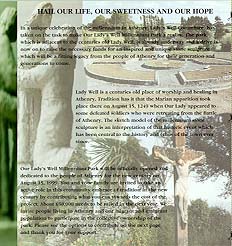 CARNAUN
NATIONAL SCHOOL CARNAUN
NATIONAL SCHOOL Lady Well Athenry The date for the Marian apparition at Lady Well Athenry is generally given as 15th August 1249. We do not have any formal written documentation to substantiate this claim. What we have is this. Firstly the very ancient tradition that the miraculous event took place on the 15th August after “The Battle of Athenry” and secondly, an ancient account in the Annals of Iar Connacht that a major battle took place in Athenry on 15th August 1249. This battle is not to be confused with the later and more famous battle of Athenry which was fought on 10th August 1316. The Annals record that the Normans, within the town, beseeched the attacking Irish not to dishonour the feast by attacking on that day. The Irish did attack and were defeated. Tradition preserves for us the legend that Our Lady appeared to some of the defeated soldiers as they were retreating from the battle. We can be quite certain that the promotion of Marian devotion would have been a very important priority for the New Dominican order whose Priory had just been built in the town (1241) since their founder St. Dominic (1170 1221), was a great apostle of the Rosary. Given these facts, there seems little reason to doubt the authenticity of the tradition of the apparition. 
At least two monuments at the well date from medieval times. While we cannot be certain that the well was the original location for either of these, the fact that they have been located at the well for at least three centuries shows a continuity of the tradition honouring this location as a place of prayer. The Celtic Pieta which at present is set in the outer wall of the well dates from the 14th century. Until the recent renovations it was placed in the inner corner where the statue now stands. It is quite unlike the continental pieta in style as the mother holds the body of the dead Christ not cradled in her arms but in an almost upright position and tradition suggests that it was defaced by soldiers during the Cromwellian Wars. The “Headache Stone”, or the large rectangular stone with the cavity in the centre was a socket for a medieval cross. There is a very strong tradition of personal healing associated with this stone. The Well has been a major centre of pilgrimage for generations. In the last century it was a place of pilgrimage for people from all over South Connemara, Who came in thousands on 15th August. While devotion to the place weaned somewhat in the 1950’s and 1960’s it was always a place of prayer for the people of Athenry and in recent years is again growing greatly in popularity.
It is a place of private prayer for the people of the district throughout
the year an especially around the time of Lady Day. In recent years that
practise of having public prayers at the Well on a specific day each month
has grown. Public Prayers are recited at the Well on the following days
to correspond with the feasts of Our Lady.
The public prayers are either on the eve of the feast, or on the Feast Day. The Parish Newsletter of the Previous week gives the time each month. Normally during the summer the time is 9:00pm and an earlier time during the winter. Monsie Kennedy Back to School Projects!
SCOIL NÁISIÚNTA CARNÁIN |